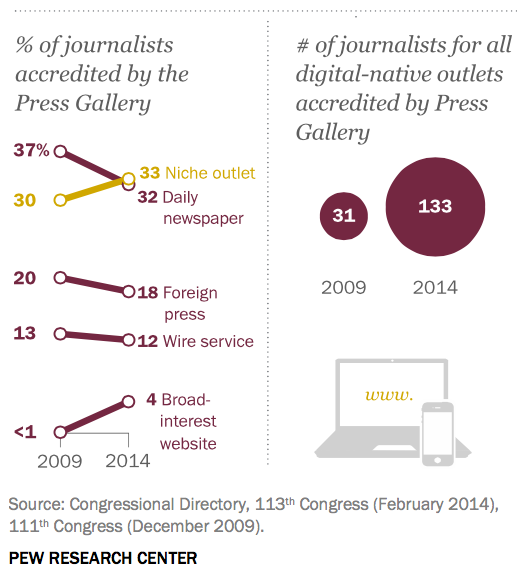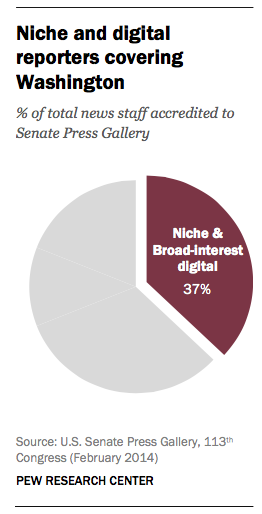
Reporters from digital outlets and niche publications now hold more seats in the U.S. Senate Press Gallery than reporters from daily newspapers do, according to a new report from Pew. That’s a change from the late 1990s, when “daily newspaper staff outnumbered such journalists by more than two-to-one.”
As local newspapers shut down and other papers close their Washington bureaus, that means that readers who want “digital options for coverage at the national level” — as well as those who can pay for premium subscription products — might be getting more coverage than they would have in the past, but there’s a “continued strain on Washington reporting for local communities, which focuses on those communities’ elected representatives, interests, and needs,” said Amy Mitchell, Pew’s director of journalism research.

Pew looked at “coverage of the federal government in eight local newspapers from across the U.S., four with a D.C. reporter and four without,” over four months this past spring, in an attempt to see how “coverage from Washington-based correspondents might differ from coverage coming from newspaper staff not stationed in D.C., wire services or other national media.”
It found that “of all the coverage about federal government appearing in these papers, the portion that comes from D.C.-based reporters accounts for less than 10 percent. Instead, the greatest portion of federal government coverage by far comes from wire service stories.” In addition, these D.C.-based reporters were less likely to focus on various issues’ impact on citizens.
Among Pew’s other findings:
 — Journalists from “niche outlets and broad-interest websites” made up 37 percent of the Senate Press Gallery in 2014, a 32 percent increase from 2009.
— Journalists from “niche outlets and broad-interest websites” made up 37 percent of the Senate Press Gallery in 2014, a 32 percent increase from 2009.
These broad-interest websites include outlets like The Huffington Post and BuzzFeed; “73 journalists working for such an organization were accredited to the Press Gallery in 2014,” up from just two in 2009.
Sixty journalists working for “niche digital-native sites,” like Kaiser Health News and Inside Higher Ed, were accredited, up from 29 in 2009.
— If you’re wondering where Politico is, its journalists aren’t counted in the Press Gallery, but in the Periodical Gallery:
— “Few of these journalists work for digital-native publications whose mission is to serve a local community,” Pew notes. While sites like The Texas Tribune and MinnPost now have a Washington correspondent, “these amount to a small fraction of the total number of journalists staffing digital news operations more generally, which often focus on national politics rather than the local or regional implications of what happens inside the Beltway.”Politico…more than doubled its accredited Washington staff from 43 to 112 between 2009 and 2014. Talking Points Memo and Townhall — two politics websites with no accredited staff in 2009 — had a combined 19 in 2014. Newer entrants in the past year include Vox Media, which launched Vox.com at its Washington headquarters in 2014.
— Local newspapers “play an outsized role in delivering news about federal government,” Pew found, largely because they rely heavily on wire services. Mainstream wire service reporters covering Washington made up 12 percent of the Senate Press Gallery in 2014, about the same as in 2009. (The majority of those reporters are from the AP.) This wire service coverage is not local, Pew laments:
What is not clear in the data is the orientation of these journalists — specifically, the extent to which some serve particular states and regions around the country, monitor the committee activities and votes of specific members of Congress, or track the decisions made at specific agencies which might have implications for communities outside the Beltway. The Press Gallery lists include journalists’ names, but not their assignments. Detailed information was not found on the AP’s website. And multiple attempts to obtain information directly from the AP Washington bureau were unsuccessful. There is some suggestion in the content analysis that most are nationally focused, or at least produce nationally oriented coverage, as the vast majority of wire stories carried in the newspapers studied did not contain a local angle.